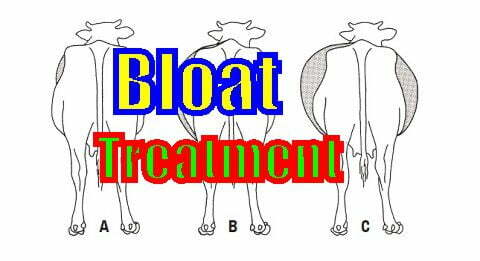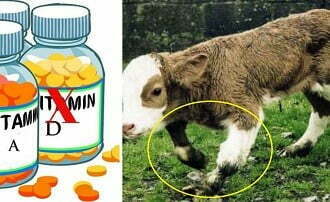Probiotics for cattle can provide many benefits. The benefits have been tested and the results are quite consistent. Especially in increasing livestock productivity. This could be in terms of livestock health, lower ration conversion, reduced cage odor, higher quality meat production or higher milk production.
If we talk about probiotics for cattle, it relates to living microbes. And these microbes are given (in feed / drink / directly) to cows. But we can’t ignore that there are microbes in the rumen too. This means that the probiotics that we will give must not be hostile to existing microbes.
At work, they should not kill each other. It should be mutually reinforcing, so that positive results will be obtained.
Benefits of probiotics for cattle
In fact, cattle are not able to completely break down the crude fiber bonds in very high crude fiber feeds. Tested, with this feed, the level of digestibility is low. Meanwhile, feed with lower crude fiber has a higher digestibility level.
Are rumen bacteria weak or limited in their abilities? I don’t think so. The ability of rumen bacteria is the best.
The problem lies in the time or length of fermentation that takes place in the rumen. This is in my opinion.
Feed in the digestive tract of ruminants only stops for a few hours. As long as it’s been able to destroy the feed so good.
Try to compare it with the fermentation of feed that we do. Fermentation for days – days only lowers a small amount of crude fiber. Defeated badly when compared to the performance of rumen bacteria.
The point is on the feed. Feed that can be digested better, the nutrients absorbed by animals are also more. So, it can directly provide the following benefits.
- Improved feed digestibility.
- More nutrients are taken from the feed.
- The use of feed becomes more effective.
- The growth of the cow is getting better.
- ADG of cattle could be higher.
- Milk production is higher. For dairy cows and lactating cows.
- With adequate nutrition, cows become healthier.
- Healthy cows have strong antibodies to ward off disease.
- Ammonia impurities are reduced. So the cage doesn’t smell too bad.
- If numbers 1 – 9 are all correct, the farmer will be happy.
According to research, giving probiotics to limousine cross cows can provide 4 ounces higher ADG than cows that are not given probiotics.[1]
It was reported that the cattle used during the study had an average ADG increase of 1.25 kg/head/day. The difference of 4 ounces is a huge improvement. This directly proves the benefits of probiotics in numbers 3, 4 and 5 above.
Whereas in another study, the addition of probiotics as much as 1% of the amount of feed, can increase the milk production of dairy cows between 2-3 liters per day.[2]
Next we can go further to discuss the types of bacteria that can be used as probiotics for cattle.
Microbes of Probiotics for Cattle
Not all microbes can be used as probiotics. Microbes used for probiotics must be able to support microbes from the rumen. In addition, it should not be harmful to their own livestock.
Therefore, there are conditions that must be met for microbes that can be used as probiotics.
Microbes are not toxic or produce substances that can poison livestock.
Not pathogenic. That can cause disease or infection in cattle.
Microbes are clearly identified. Is it a lactobacillus, saccharomices, or other type of microbe.
Can live in the body of livestock. This means that bacteria must be able to survive in the environment of the animal digestive system. This means that microbes must be able to adapt to the pH conditions of livestock digestion.
Microbes must be stable and able to survive in the storage process.
Has a fairly high microbial volume.
The ideal source for making probiotics for cattle is the rumen. The contents of this rumen can be taken from the slaughterhouse.
This is because the bacteria in the rumen will be the same as the types of microbes in the rumen. If during handling it is not contaminated with other bacteria.
What micro-organisms are found in the rumen?
Lots. Among them are microbes, methanogens, protozoa and anaerobic fungi. All these micro-organisms are anaerobes.
Microbes or bacteria will be divided again according to their work specifications. There is a special breakdown of cellulose, sugar, dextricin, hemicellulose, pectin, nitrogen and protein decomposers.
Briefly, it can be seen in the table below.
| ——————- | Funtion | Types |
| Microbes | Utilizing cellulose | Ruminococcus albus, |
| Fibrobacter succinegenes, | ||
| Eubacterium cellulosolvens | ||
| hemiselulosa | Butyrivibrio fibrisolvens | |
| Starch | Streptococcus bovis | |
| Sugar or dextrin | Succinivibrio dextrinosolvens | |
| Lactobacillus sp. | ||
| pektin | Treponema saccharophilum | |
| Lachnospiramultiparus | ||
| Protein degradation | Ruminibacteramylophilus, | |
| Clostridium sp. | ||
| Urea hydrolysis | Megasphaera elsdenii | |
| Acid user | Succiniclasticum ruminis | |
| lipolitik, | ||
| Metanogen | Acetogenic, anti-nutritive degrading, and archaea | Methanobrevibacter ruminantium |
| Methanosarcina sp | ||
| Methanosphaerastadmanae | ||
| Methanoculleus bourgensis |
How to make homemade probiotics for cattle
There are several ways we can do to get more probiotics. The easiest step is to culture microorganisms in existing probiotics.
This step is easier and more practical than having to make from new materials. Because creating new probiotics it is difficult to know the density of bacteria. In addition, it is quite difficult to control the presence of other bacteria that might enter our probiotics.
Probiotics for cattle from rumen liquid
We can make probiotics for cattle from rumen liquid. The rumen contents were taken from healthy cows. It is feared, if the cow is infected with a disease (pathogenic bacteria or virus).
Later, these pathogenic bacteria or viruses can also be included in the probiotics that we make. The contents of the rumen can be made probiotics in liquid or solid dosage forms. It depends on the capabilities and equipment we have.
Making probiotics for cattle from rumen contents is easier. These are the steps.
- Prepare the ingredients
The ingredients used are 100 grams of fresh rumen contents, 200 grams of molasses/brown sugar and 5 liters of clean water.
- Prepare the water
Prepare as much as 5 liters of clean water. Don’t use hard water.
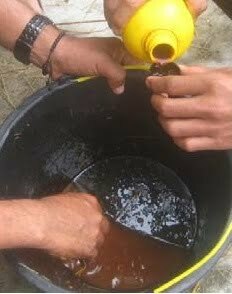
- Adding Molasses
Add molasses and rumen contents to the water above.
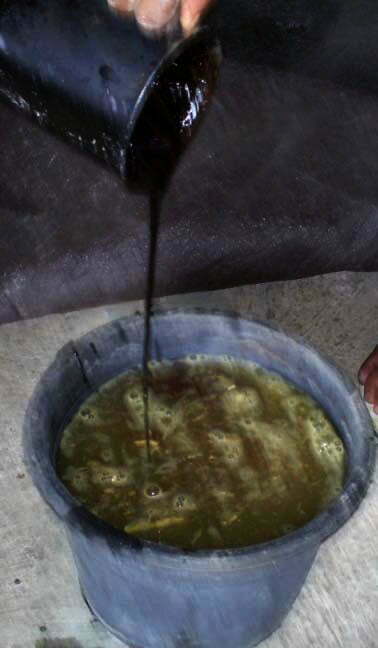
- Mix it
Stir until evenly mixed. If the molasses is not available, it can be replaced with brown sugar that has been mashed.
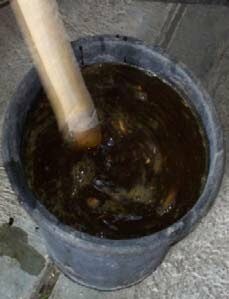
- Close it
Simple like that. Only stay closed tightly for at least 12 hours. Probiotics or starters are ready to use if there is a white color floating on the surface.
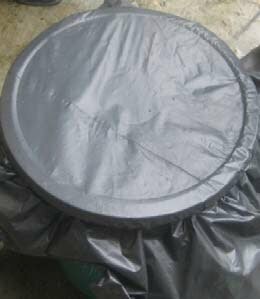
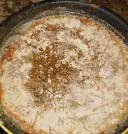
Reference
[1] https://kambingjoynim.com/penggemukan – sapi – limosin – 1-kg-lebih-per-hari-probiotik-hasilnya-lebih-baik/ . [2] Prihartini, Indah and Khusnul Khotimah. Production of Lignochloritic Bacteria-Based Rumen Probiotics and Its Application in Dairy Cattle. http://ejournal.umm.ac.id/index.php/gamma/article/view/1417 [3] Haryanto, Budi. Use of Probiotics in Feed to Improve Carcass and Lamb Meat Quality. JITV Vol. 5. No.4. Th. 2000. [4] Masnun, S.Pt., M.Si, Making bioplus from rumen contents. [5] Ridwan, Roni. 2014. Microbial Diversity and Rumen Metabolism of Ongole Crossbreeds Consuming Grass-Legume Silage Feed. Postgraduate School of IPB Bogor. JOYNIM FARM Goat Farming, Cattle Farm, Laying Hens, Quail Farm, Gardening
JOYNIM FARM Goat Farming, Cattle Farm, Laying Hens, Quail Farm, Gardening
